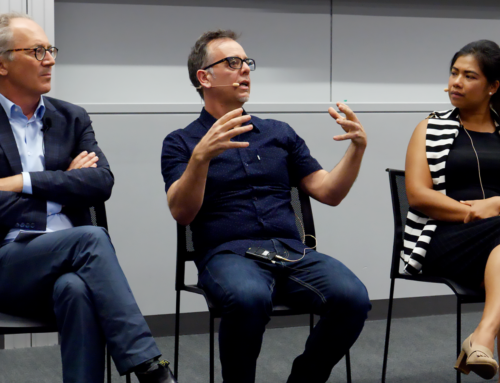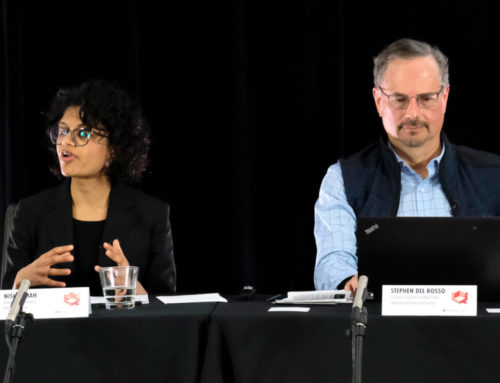After the first day of panels, complex conversations carried over to drinks, dinner and even a pitched game of eight ball in which the billiard ball theory was briefly appropriated for strategic reasons by a motley crew of new materialists, physicists and post-structuralists.
Sunrise Saturday morning saw participants particle-scattered across the inviting scenery of Q Station to indulge in the site’s natural beauty- its tranquil cove and beach, bush trails, and commanding views of the harbor. Many then gathered for an informative tour of Q Station given by Q Symposium presenter Alison Bashford, who leads an interdisciplinary project on historic immigration and quarantine stations at Angel Island (San Francisco) and Grosse Îsle, Québec.

Q Symposium participants take in a tour of Q Station given by Alison Bashford, in white. (Photo: Jose Torrealba)
After the conclusion of the tour, the Symposium reconvened in the conference room to begin the day’s proceedings with the Biosecurity: Microbes, Food, and Genes panel, moderated by Adam Kamradt-Scott and drawing together a capable contingent of scholars working with the entanglement of global security, health and biopolitics.
Kamradt-Scott opened the panel by informing the audience that 48 hours earlier, a team of scientists at Harvard had successfully used microchips implanted in monkeys to allow one monkey to control the movements of another sedated “avatar”. The increasingly rapid pace of advances in biological science is often Janus-faced, heralding immense transformative potential but also increasingly varied and complex security concerns. Scientists have recreated polio and the SARS coronavirus through increasingly accessible techniques and technology, and community labs presage increased proliferation advanced biology and genomic know-how and technology. According to Kamradt-Scott, both threats and technology are collapsing geographical, temporal and cognitive boundaries at a rapid rate as pandemics, food security, and population issues become global events and potentially non-linear catastrophes with astonishing speed.
With that, he handed off the panel to the Alison Bashford, already warmed up for her second presentation of the morning. Bashford, a historian, presented her research as coming from the intersecting history of disease management, IR, and security. However, her research today started from a shift in focus, from a biosecurity notion emphasizing microbes and infectious disease to the traditional biopolitics of reproduction and population.
She explained that population growth had long been considered a central issue in classical IR, only dropping away from eminence in the 1980s and 90s. But with increasing consciousness of the imminent effects of climate change and food crises, biopolitics and geopolitics are pushed increasingly towards entanglement and complementarity.

Allison Bashford (USydney) speaks about her research, with Kathleen Vogel (C) and Monika Barthwal-Datta (L) beside her. (Photo: Jose Torrealba)
In Bashford’s estimation, population is as much a matter of concern for security now as it was in the early days of IR when it formed a triad with war and peace as the preeminent international concerns, with the utility of a biopolitic/biosecurity distinction less and less useful. In this we are witnessing a return to questions of classical IR, the same faced by American philanthropist John D Rockefeller 3rd who wondered if he’d be better focusing his investments towards the biopolitics of reproductive issues or food security. A response from American scientist Warren Weaver, cited by Bashford in her book Global Population: History, Geopolitics, and Life on Earth, proposed a novel solution aiming to use solar energy and technology to decouple human sustenance and energy production from territory altogether. In this, the same technological collapsing of geography and temporality highlighted by Kamradt-Scott in his opening remarks ties population consideration to the emergent complementarity of geopolitics and biosecurity.
The panel’s second speaker, Monika Barthwal-Datta, continued the broadening of biosecurity from population issues to food security. Barthwal-Datta, who led a 2-year research project on “Food Security in Asia” funded by the MacArthur Foundation and hosted at the Centre for International Security Studies at University of Sydney (the results of which culminated in a book), used her presentation to present an overview of the reemergence of food security as a matter of global concern in light of the global food crisis in 2007-08.
At the turn of the millennium, she explained, food security had been largely subsumed into the discourse of human development and the Millennium Development Goals. This was an evolution from the UN Food and Agriculture Organization’s emphasis in the 1970s on macroeconomic factors of supply and demand through food security, and finally a focus on access in the early 2000s. But beginning in 2006, global food prices experienced a sharp increase in prices. Governments had by and large been unconcerned with food prices during the “Green Revolution” of agriculture assistance and technology/technique transfer, and had become, in Barthwal-Datta’s eyes, complacent.
This sense of security collapsed with the price increase resulting from a complex combination of factors, including but not limited to: crop diversion towards biofuels, rising oil prices, financial speculation, extreme weather events and export bans. The resultant economic crisis pushed 40 million people worldwide into poverty and provoked widespread social unrest, highlighting the vulnerability of state underdevelopment and dependency on global food markets.
The global implications triggered a global response– the UN convened a high-level task force and commissioned an FAO summit, while food security pushed up the agenda of the G8. At the national level, focus again shifted to macroeconomic factors, with immediate responses reevaluating export/import controls while longer-term responses reflected increasing skepticism of the stability of the global market and increased emphases on agricultural self-sufficiency.

Monika Barthwal-Datta presents her research on food security, as panel participants (L-R) Kathleen Vogel, Alison Bashford and Stefen Elbe look on. (Photo: Jose Torrealba)
Barthwal-Datta concluded her talk by highlighting the impact of these moves for international security writ large. The increasing entanglement of the globalized world reflects for agriculture the collapse in traditional territorial boundaries with food security. We see a shift away from the discourse of human security back to a national, state-centric macro approach to food security. Nonetheless, Barthwal-Datta says that for key actors it’s business-as-usual, who emphasize only on increasing production rather than addressing the increasing complexities of these systems.
While the emphasis on population and food as elements of biosecurity was a welcome complement to conceptions of the notion, microbes and disease made their panel debut in the presentation of Stefan Elbe, director of the interdisciplinary Centre for Global Health Policy at the University of Sussex. Titled “Pandemic Threats, Medical Countermeasures, and the Pharmaceuticalization of Security,” Elbe’s presentation traced recent developments in biosecuritization of pandemic preparedness and response.
Modern pandemics, aided by global media saturation, are epitomic global events. However, classical pandemic detection remains difficult. But with new technology comes new practices, and Elbe spotlighted new systems of syndromic surveillance by looking at non-traditional indicators such as Google search-terms based on individuals looking up their symptoms. This and other methods have been institutionalized in Canada’s Global Public Health Intelligence Network (GPHIN), which monitors, analyzes and disseminates relevant information on outbreaks and other events of significance for public health and shares them with international organizations and other relevant actors.
These new surveillance capabilities are complemented by capabilities for international action as well, as the WHO no longer has to wait for sovereigns to act. Meanwhile, media both observes and shapes responses, resulting in a Copenhagen interpretation-informed relaxation of the subject/object dichotomy. All this highlights the complex interdependence between global events and interventions aimed at disease control.
What can governments do to prepare for and face pandemic threats? Elbe provided some options. Firstly, they can do nothing. Secondly, they can rely on direct public health interventions, like quarantines. They can pursue a containment approach, emphasizing monitoring and treating isolated strains and working to preempt mutations. While each approach has some manifestation in policy, governments have sought to circumvent the social traumas of direct interventions by turning to pharmaceuticals. Policymakers seem convinced that pharmaceuticals provide a sufficient intervention capability and preparedness without the system disruptions caused by more traditional public health interventions.
This trend towards pharmaceuticalization, Elbe argued, is a result of the entanglement of politics, economics, and societal factors. He highlighted, without comment, the fact that former Secretary of Defense Donald Rumsfeld (subject of Errol Morris’s The Unknown Known which was to be shown that night) and former Secretary of State George Schultz (who coined the term “quantum diplomacy”) had both served on the board of Gilead Sciences, whose product Tamiflu was stockpiled by governments worldwide as a medical countermeasure to potential flu pandemics in the name of biopreparedness. Elbe concluded convincingly that this pharmaceuticalization is a crucial phenomenon in the continued securitization of public health.
Concluding the presentations was Kathleen Vogel, whose presentation explored science and tech diffusion in the field of synthetic biology. Vogel, who holds a joint appointment at Cornell University in the Department of Science and Technology Studies and the Judith Reppy Institute for Peace and Conflict Studies, explained that synthetic biology was an emerging, interdisciplinary biological field that involves the design and construction of new biological parts, devices and systems that do not exist in nature and the re-design of those that do.
How can we understand notions of security and threat in synthetic biology? Existing frameworks, such as the “revolution” frame, fall short in explanatory capability, according to Vogel. Claiming a hegemony of the “revolution” frame for most government and non-government assessments of synthetic biology, relying on notions of “a biotech revolution” or “an informatics revolution”, these focus largely on information, material, and technological aspects of the processes. As such, they assume increasingly efficient and streamlined diffusion and tech transfer, as well as technology and threat trajectories that are linear or exponential, leading to particular conceptions of security and policy.

Kathleen Vogel presents her research on synthetic biology on the Biosecurity panel at the Q Symposium. (Photo: Jose Torrealba)
Instead, Vogel made a call for a complementarity of fine-grain micro and macro level studies of synthetic biology and its diffusion, able to qualitatively account for the micro-processes of diffusion of praxis and techne and taking into account as well the importance of socio-organizational factors. With informatics, emphasis on certain materialities like declining costs, increasing capabilities and reliabilities are not drivers for widespread diffusion, with Vogel citing James Cortada’s The Digital Flood in emphasizing that factors other than the technology itself drives its diffusion. Such a complementary approach leads to a better understanding of both synthetic biology and its potential security applications and threats.
After such a diverse yet compelling and coherent panel, the audience raised questions touching on attempts, like Soylent, to re-conceive of food and nourishment and the potential role of technology and simulation in replacing some aspects of biology altogether. And what of the politics of securitizing population and food supply? These discussions and more carried over to lunch, as the panel broke on a now-familiar note of indeterminacy, complexity and complementarity for the time being.






[…] softly towards a Sydney summer sundown. Panels had touched on so many facets of security studies, natural and social science, ethics, epistemology, and security aesthetics that a single closing panel would […]
[…] Bashford’s presentation for the biosecurity panel mentioned a mid-20th century idea of Warren Weaver to develop an independent, solar energy source […]